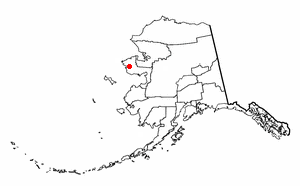Mary's Igloo, Alaska on:
[Wikipedia]
[Google]
[Amazon]
 Mary's Igloo (''Qawiaraq'' in Iñupiaq) is an abandoned village located in the
Mary's Igloo (''Qawiaraq'' in Iñupiaq) is an abandoned village located in the
Nome Census Area
Nome Census Area is a census area located in the U.S. state of Alaska, mostly overlapping with the Seward Peninsula. As of the 2020 United States census, 2020 census, the population was 10,046, up from 9,492 in 2010. It is part of the unorganiz ...
of the Unorganized Borough
The Unorganized Borough is composed of the portions of the U.S. state of Alaska which are not contained in any of its 19 organized boroughs. While referred to as the "Unorganized Borough," it is not a borough itself, as it forgoes that level of ...
in the U.S. state
In the United States, a state is a constituent political entity, of which there are 50. Bound together in a political union, each state holds governmental jurisdiction over a separate and defined geographic territory where it shares its sover ...
of Alaska
Alaska ( ; russian: Аляска, Alyaska; ale, Alax̂sxax̂; ; ems, Alas'kaaq; Yup'ik: ''Alaskaq''; tli, Anáaski) is a state located in the Western United States on the northwest extremity of North America. A semi-exclave of the U.S., ...
, now used as a fish camp. Many former residents and their descendants currently live in nearby Teller
Teller or telling may refer to:
People
* Teller (surname)
* Teller (magician), one half of the duo Penn & Teller
Places
* Teller, Alaska, United States
** Teller Airport
* Teller County, Colorado, United States
Other uses
* 5006 Teller, a minor ...
or the next largest community, Nome.
History
The Inupiat village of ''Kauwerak'' was located about downriver from Mary's Igloo. By 1900, Kauwerak was abandoned and most of its residents moved to Teller or Nome because of schools and employment opportunities. A few settled at the site of Mary's Igloo, which they called ''Aukvaunlook'', meaning "black whale." During the gold prospecting period of the early 1900s, non-Natives
Indigenous peoples are culturally distinct ethnic groups whose members are directly descended from the earliest known inhabitants of a particular geographic region and, to some extent, maintain the language and culture of those original people ...
named the village "Mary's Igloo," after an Inupiat woman named Mary, who welcomed miners, trapper
Animal trapping, or simply trapping or gin, is the use of a device to remotely catch an animal. Animals may be trapped for a variety of purposes, including food, the fur trade, hunting, pest control, and wildlife management.
History
Neolithic ...
s and others into her home for coffee. During that period, Mary's Igloo was a transfer point for supplies for the gold fields upriver on the Kuzitrin and Kougarok rivers. The supplies were offloaded from ocean boats onto barges, which were towed to their destinations. A post office and store were opened at Mary's Igloo in 1901. By the 1910 census, Mary's Igloo was a community of 141 Inupiat and Anglo-Americans, who were miners, innkeepers, missionaries and support crews for the barges. It had schools, a post office and other services.
The flu epidemic of 1918 and 1919 and a tuberculosis epidemic, two years later, decimated the community's population. Catholic
The Catholic Church, also known as the Roman Catholic Church, is the largest Christian church, with 1.3 billion baptized Catholics worldwide . It is among the world's oldest and largest international institutions, and has played a ...
and Lutheran
Lutheranism is one of the largest branches of Protestantism, identifying primarily with the theology of Martin Luther, the 16th-century German monk and reformer whose efforts to reform the theology and practice of the Catholic Church launched th ...
orphanages opened in the area to care for children left without parents.
The schools closed in 1948 and 1950 for lack of students and the post office and store also closed in 1952. Most of the residents moved to Nome or Teller.
The site of Mary's Igloo presently has no permanent population. It is used as a seasonal fish camp by some residents of Teller.
Demographics
Mary's Igloo first appeared on the 1910 U.S. Census as "Igloo", an unincorporated village. It did not officially appear as Mary's Igloo until 1950. It did not appear again on the census until 1980, although the population was zero. It was classified as an Alaskan Native Village Statistical Area (ANVSA). It has not reported any residents since.Geography
Mary's Igloo is located at ., on the northwest bank of theKuzitrin River
The Kuzitrin River (''Kurritqiun'' in Inupiaq) is a stream, long, on the Seward Peninsula in the U.S. state of Alaska. It begins at Kuzitrin Lake in the central region of the peninsula and flows west into the Imuruk Basin. The basin drains via ...
, on the Seward Peninsula
The Seward Peninsula is a large peninsula on the western coast of the U.S. state of Alaska whose westernmost point is Cape Prince of Wales. The peninsula projects about into the Bering Sea between Norton Sound, the Bering Strait, the Chukchi S ...
. It is northeast of Nome and 65 km (40 mi) southeast of Teller
Teller or telling may refer to:
People
* Teller (surname)
* Teller (magician), one half of the duo Penn & Teller
Places
* Teller, Alaska, United States
** Teller Airport
* Teller County, Colorado, United States
Other uses
* 5006 Teller, a minor ...
.
References
{{authority control Geography of Nome Census Area, Alaska Unincorporated communities in Alaska Ghost towns in Alaska Ghost towns in the United States Ghost towns in North America